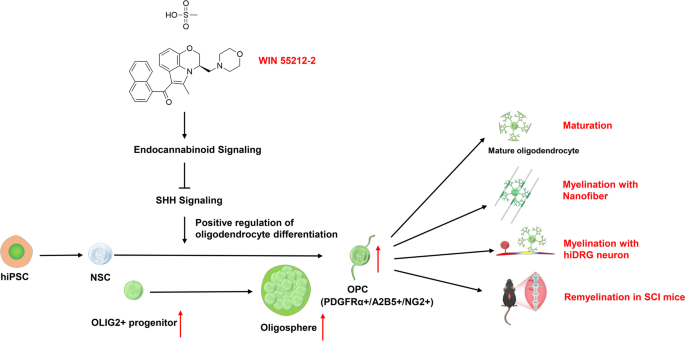
“The treatment of traumatic spinal cord injury (SCI) remains challenging as the neuron regeneration is impaired by irregular cavity and apoptosis. An injectable in situ gelling hydrogel is therefore developed for the local delivery of cannabidiol (CBD) through a novel method based on polyelectrolyte (PEC) interaction of sodium carboxymethylcellulose (CMC) and chitosan (CS). It can be injected into the spinal cord cavity with a 26-gauge syringe before gelation, and gelled after 110 ± 10 s. Of note, the in-situ forming hydrogel has mechanical properties similar to spinal cord. Moreover, the CBD-loaded hydrogels sustain delivery of CBD for up to 72 h, resulting in reducing apoptosis in SCI by enhancing mitochondrial biogenesis. Importantly, the CBD-loaded hydrogels raise neurogenesis more than pure hydrogels both in vivo and in vitro, further achieving significant recovery of motor and urinary function in SCI rats. Thus, it suggested that CMC/CS/CBD hydrogels could be used as promising biomaterials for tissue engineering and SCI.”
https://pubmed.ncbi.nlm.nih.gov/36075309/
https://www.sciencedirect.com/science/article/abs/pii/S0141813022019353?via%3Dihub





 “Objectives: To evaluate the impact of cannabinoids on neurobehavioral outcomes in preclinical models of nontraumatic and traumatic spinal cord injury (SCI), with the aim of determining suitability for clinical trials involving SCI patients.
“Objectives: To evaluate the impact of cannabinoids on neurobehavioral outcomes in preclinical models of nontraumatic and traumatic spinal cord injury (SCI), with the aim of determining suitability for clinical trials involving SCI patients. “People with spinal cord injuries (SCI) commonly experience pain and spasticity, but limitations of current treatments have generated interest in
“People with spinal cord injuries (SCI) commonly experience pain and spasticity, but limitations of current treatments have generated interest in